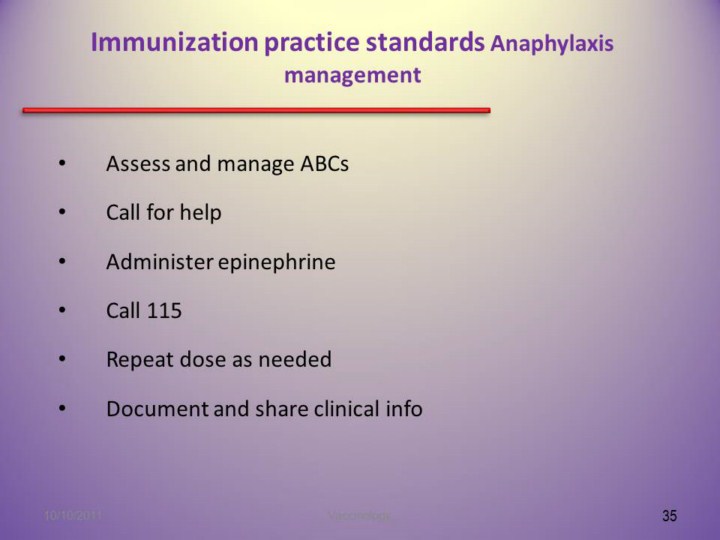Search for most updated materials
 |
 |
front |1 |2 |3 |4 |5 |6 |7 |8 |9 |10 |11 |12 |13 |14 |15 |16 |17 |18 |19 |20 |21 |22 |23 |24 | 25|26 |27 |28 |29 |30 |31 |32 |33 |34 |35 |36 |37 |38 |39 |40 |41 |42 |43 |44 |review |
 Reference : NB Immunization Handbook, section IV-XII, appendix XV Anaphylaxis : life-threatening allergic reaction which results in multiple body system abnormalities. Signs and symptoms can usually be reversed by treatment with epinephrine.
SYMPTOMS (Cardinal features)
•Itchy,
urticarial rash (90% of cases)
•Angioedema
around face and mouth with itchiness, tearing, nasal congestion, facial
flushing
•Respiratory
symptoms : sneezing, coughing, wheezing, laboured breathing, upper
airway swelling (hoarseness and difficulty swallowing)
•Hypotension:
can progress to shock and collapse
Anaphylaxis management History of anaphylaxis taken prior vaccination Assess and manage ABCs Call for help : one nurse on-site will be available to manage anaphylaxis. Call 911 : Design someone to call 911 Epinephrine administration (PHN responsibility)- If 2 or more signs/symptoms OR If one or more signs/symptoms and previous history, give Epinepherine (1:1000) SC 0,01 ml/kg or per dosage table in unvaccinated limb; repeat dose if no improvement in 15 minutes Share info with ambulance personnel Epinephrine table Age Dose ml Dose mg 2-6 mths 0.07 0.07 (minimum dose) 12 mths 0.10 0.10 18 mths-4 yrs 0.15 0.15 5 yrs 0.20 0.20 6-9 yrs 0.30 0.30 10-13 yrs 0.40 0.40 14 yrs and more 0.50 0.50 (maximum dose) |
|